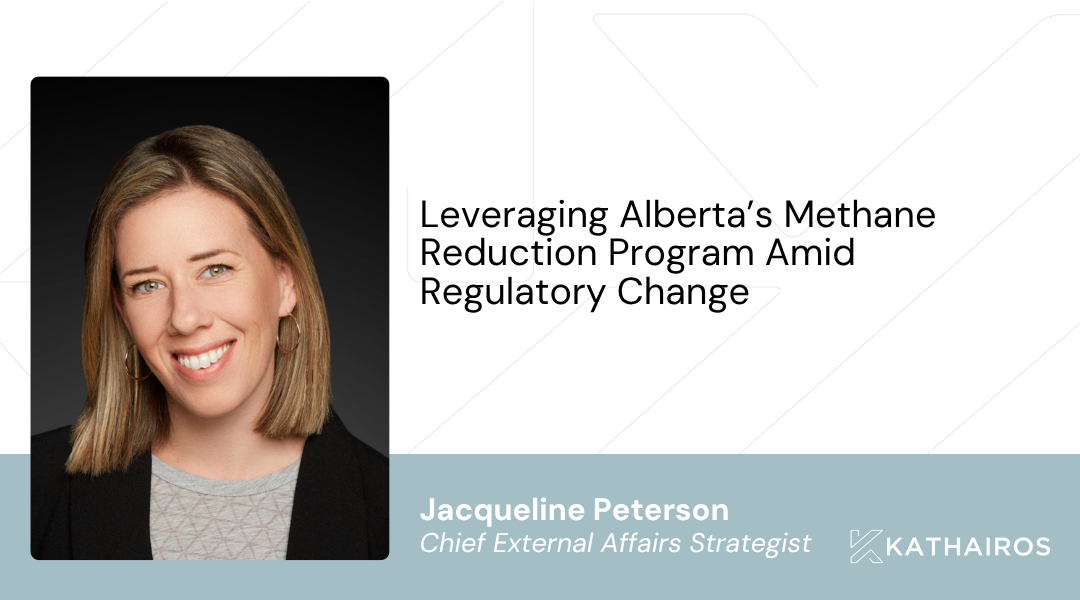
Kathairos has emerged as the leading North American solution for methane elimination from pneumatics, with more than 2,400 systems in operation across North America and over 70 major oil and gas producer partners.
In this post
Last week, Kathairos Solutions was invited by the Petroleum Technology Alliance of Canada (PTAC) to present at an event discussing advancements in well site methane emissions reduction.
Jacqueline Peterson, Kathairos’ Director of Policy and Offsets, presented at PTAC/CRIN’s Focused Conversations: Reducing Methane Emissions from Well Sites, an event held in Calgary, Alberta that featured four new methane elimination technologies either in field testing or in early deployment.
The Challenge of Scale, the Promise of Nitrogen
In her presentation, Peterson focused on the problem of methane venting from pneumatics, which is what the Kathairos Solutions addresses.
Pneumatic emissions make up roughly a third of oil and gas methane emissions yearly, representing a massive area of reduction potential. While these emissions may not seem so significant on an individual site level (at least in relative terms, compared to other emitting facilities), they build up when aggregated: over 400,000 remote well sites are currently exist in North America.
While solutions do exist, Peterson stressed that the problem is in finding a non-methane venting solution that is economical (even for small sites) and can be scaled across industry quickly.
Methane is a particularly bad greenhouse gas and is an immediate target area, with over 100 countries already having signed onto the Global Methane Pledge, which aims to cut 2020 methane emissions 30% by 2030.
As such, there is an urgency to finding a solution to methane emissions that is unlike other technological roll-outs from the past.
The Regulatory Landscape
All oil and gas producing regions recognize that to significantly reduce methane emissions, it will be essential to eliminate the practice of routine venting from pneumatics, which constitute a significant source of methane emissions.
Numerous jurisdictions are already acting to ban natural gas driven pneumatic pumps and controllers: in the US, changes to the Clean Air Act (OOOOb and OOOOc) now require all pneumatic pumps and controllers to be zero-venting by the end of 2027. These regulations are scheduled to be adopted in August.
In Canada, the federal government’s methane reduction framework also includes bans on methane venting from pneumatics, with a similar expected timeline to the US and further details to be released over the summer.
With methane considered a top priority to address and regulations on the way to tackle the problem, one major challenge remains: how will this be accomplished, at scale?
Peterson stressed that eliminating methane venting from a technical standpoint isn’t the problem: we know how to do this! Rather, there are challenges on how to achieve this logistically, economically, and confidently.
In her presentation, Peterson identified the need to scale:
- reliable technology solutions,
- strong supply chains,
- economic incentives for early adopters, and
- regulatory certainty.
Reliable Technology Solutions
Peterson stressed that in order for a solution to be affordable, reliable, and scalable, it needs to first and foremost be simple.
This required a fundamental rethinking of the problem and how to address it, which is the approach Kathairos has taken in developing its proprietary liquid nitrogen solution.
Instead of electrifying a site- either by tying into the grid, using a generator, or using solar panels- the Kathairos solution simply changes the gas being used onsite. to actuate pneumatics. Instead of using fuel gas to drive pneumatics, Kathairos uses nitrogen gas, which is both inert and non-polluting.
Supply Chains
Logistics of such a mass deployment within a relatively short window are challenging, to say the least, and technology is only good if if it can be manufactured to keep up with demand.
Peterson identified this as a chief priority for Kathairos to address, highlighting how a relatively small, newer company leveraged (and continued to leverage) partnerships with companies of significant size, capacity, and reputation.
To develop an unparalleled network that can effectively address methane venting across nearly half a million sites across North America, Kathairos has worked to optimize manufacturing and delivery of its liquid nitrogen tanks, as well as the acquisition and distribution of liquid nitrogen to active sites.
Economic Incentives for Early Adopters
Simply put, in order to achieve ambitious reduction targets by 2025, 2030, and beyond: producers need to act now, and they all can’t wait until the last minute.
Early adoption ensures peace of mind, product availability, and certainty of supply, given that ample consideration for variables including timelines and deployment logistics nneed to be considered.
To Peterson, valuable carbon offsets and established bodies like Alberta’s TIER system provide a critical incentive for Canadian producers to act early, referencing the multitude of producers that have adopted the Kathairos solution with offset credits in mind.
Regulatory Certainty
Although Canada has provided strong indications of what’s to come with regards to the regulatory landscape, Peterson stressed the need for more certainty regarding details and timelines of proposed regulations.
This is to ensure that producers have confidence in acting early and making significant necessary investments to reduce their methane emissions.
The rapid adoption of the Kathairos solution helps illustrate this point, as dozens of major oil and gas producers have opted to tie in owing to strong regulatory pressures, especially in the US.
The Road Forward
There remains a lot of work to be done, but eliminating routine methane venting from upstream pneumatics across the industry is possible.
That said, it’s not going to happen organically on its own: commitment and action from both industry and government are crucial in ensuring that reduction targets are achieved by the proposed timelines.

.png)

